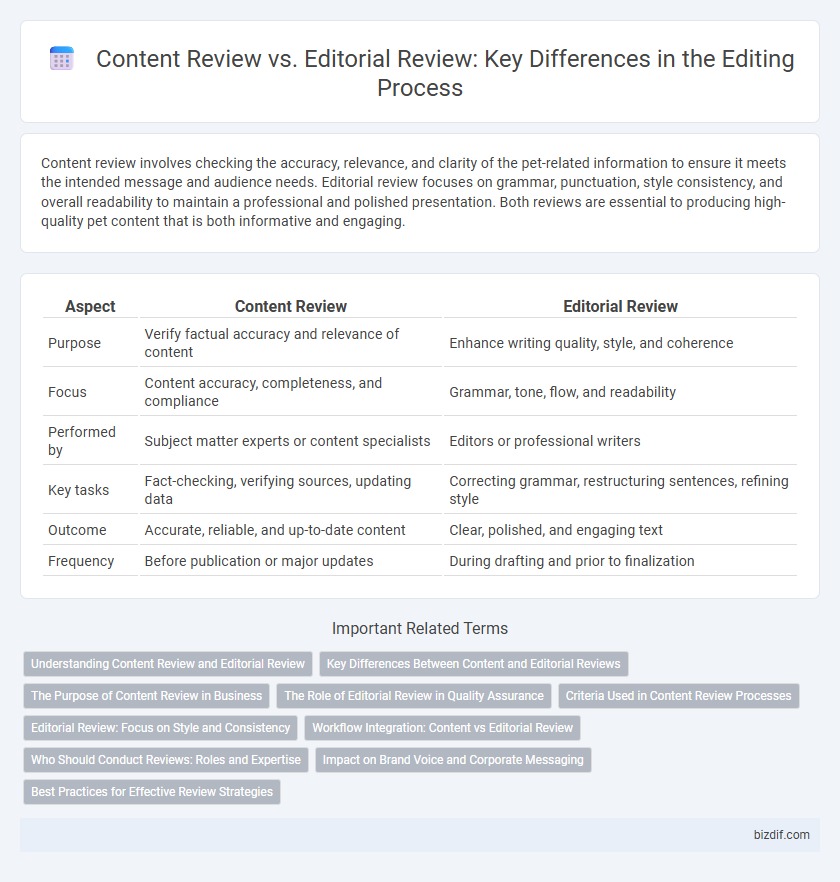Content review involves checking the accuracy, relevance, and clarity of the pet-related information to ensure it meets the intended message and audience needs. Editorial review focuses on grammar, punctuation, style consistency, and overall readability to maintain a professional and polished presentation. Both reviews are essential to producing high-quality pet content that is both informative and engaging.
Table of Comparison
| Aspect | Content Review | Editorial Review |
|---|---|---|
| Purpose | Verify factual accuracy and relevance of content | Enhance writing quality, style, and coherence |
| Focus | Content accuracy, completeness, and compliance | Grammar, tone, flow, and readability |
| Performed by | Subject matter experts or content specialists | Editors or professional writers |
| Key tasks | Fact-checking, verifying sources, updating data | Correcting grammar, restructuring sentences, refining style |
| Outcome | Accurate, reliable, and up-to-date content | Clear, polished, and engaging text |
| Frequency | Before publication or major updates | During drafting and prior to finalization |
Understanding Content Review and Editorial Review
Content review involves evaluating the accuracy, relevance, and completeness of information within a document to ensure it meets the intended purpose and audience needs. Editorial review focuses on refining language, grammar, style, and overall readability to enhance clarity and engagement. Both processes are essential in publishing workflows, with content review prioritizing substance and editorial review emphasizing presentation quality.
Key Differences Between Content and Editorial Reviews
Content review primarily focuses on assessing the accuracy, relevance, and completeness of information within a piece, ensuring factual correctness and alignment with the intended message. Editorial review emphasizes style, tone, grammar, and overall readability, enhancing clarity and consistency to meet publication standards. Key differences include content review's objective evaluation of subject matter versus editorial review's attention to language quality and presentation.
The Purpose of Content Review in Business
Content review in business ensures that all materials align with brand guidelines, messaging strategy, and target audience expectations to maintain consistency. It focuses on verifying facts, clarity, and relevance to enhance user engagement and trust while mitigating risks associated with misinformation. This process supports effective communication strategies by refining content quality before publication, boosting overall brand credibility and conversion rates.
The Role of Editorial Review in Quality Assurance
Editorial review plays a critical role in quality assurance by ensuring content accuracy, consistency, and adherence to brand guidelines through a thorough evaluation process. Unlike content review, which primarily focuses on factual correctness and relevance, editorial review scrutinizes grammar, style, tone, and overall readability to enhance the final output. This comprehensive assessment helps maintain professional standards and strengthens the credibility of the published material.
Criteria Used in Content Review Processes
Content review processes prioritize accuracy, relevance, and consistency of information within the material, ensuring factual correctness and alignment with the intended message. Editorial review criteria focus on language quality, style adherence, tone appropriateness, and grammatical precision to enhance readability and engagement. Both reviews evaluate content structure, but content review is more data-driven while editorial review emphasizes linguistic and narrative refinement.
Editorial Review: Focus on Style and Consistency
Editorial review emphasizes style and consistency, ensuring that the content aligns with the brand voice and adheres to predetermined style guides such as AP or Chicago Manual of Style. This process involves refining tone, grammar, punctuation, and formatting to maintain uniformity across all materials. By prioritizing editorial review, organizations enhance readability and professionalism, fostering stronger audience engagement and trust.
Workflow Integration: Content vs Editorial Review
Content review focuses on verifying accuracy, clarity, and relevance of information within the material, ensuring factual correctness and alignment with the target audience's needs. Editorial review emphasizes structure, style, grammar, and tone to enhance readability and coherence, often involving multiple rounds of revision for narrative flow. Integrating content review early in the workflow establishes a solid factual foundation, while editorial review finalizes the presentation, creating a seamless, efficient editing process.
Who Should Conduct Reviews: Roles and Expertise
Content review should be conducted by subject matter experts who possess in-depth knowledge of the topic to ensure accuracy and relevance. Editorial review requires skilled editors with proficiency in language, style, and grammar to enhance readability and coherence. Collaboration between these roles optimizes content quality by combining factual correctness with polished presentation.
Impact on Brand Voice and Corporate Messaging
Content Review ensures the accuracy, clarity, and relevance of information, directly maintaining the brand voice's consistency across all platforms. Editorial Review goes deeper, refining tone, style, and messaging to align tightly with corporate values and audience expectations, thereby strengthening brand identity. Both processes shape how the brand is perceived but Editorial Review has a greater impact on fine-tuning corporate messaging for strategic communication.
Best Practices for Effective Review Strategies
Content review focuses on evaluating the accuracy, relevance, and completeness of information within a text, ensuring it meets the target audience's needs and aligns with content goals. Editorial review emphasizes language quality, grammar, style consistency, and tone to enhance readability and brand voice coherence across all materials. Combining structured checklists, collaborative feedback loops, and iterative revisions accelerates error detection and improves overall content quality.
Content Review vs Editorial Review Infographic

 bizdif.com
bizdif.com